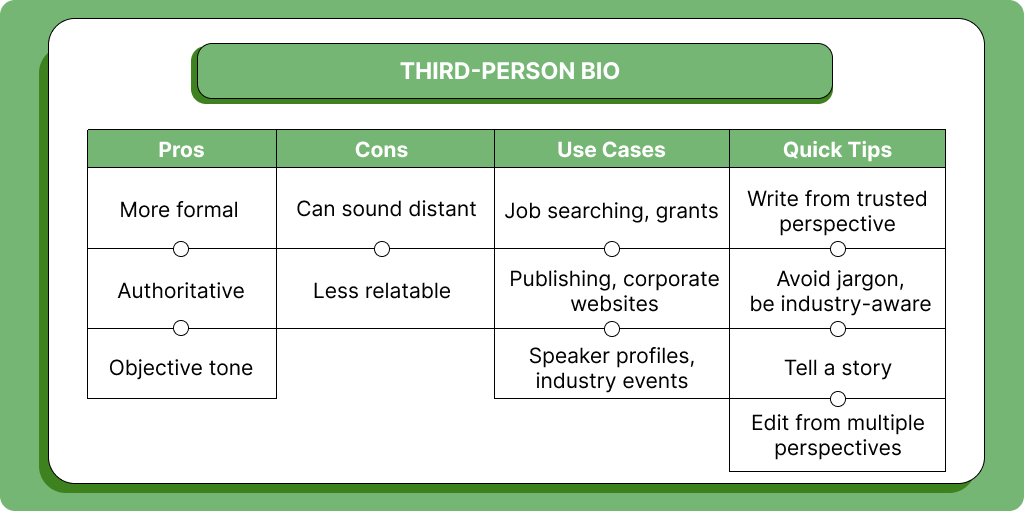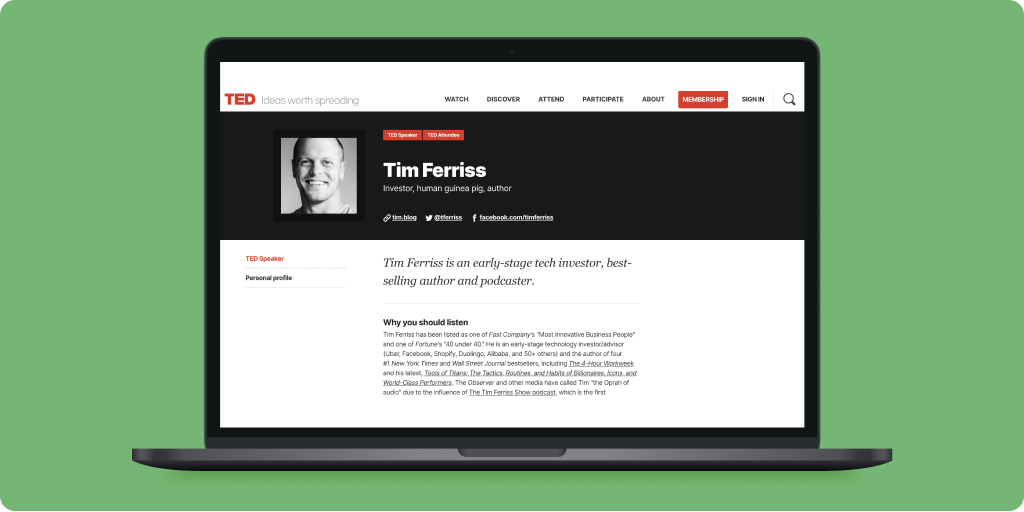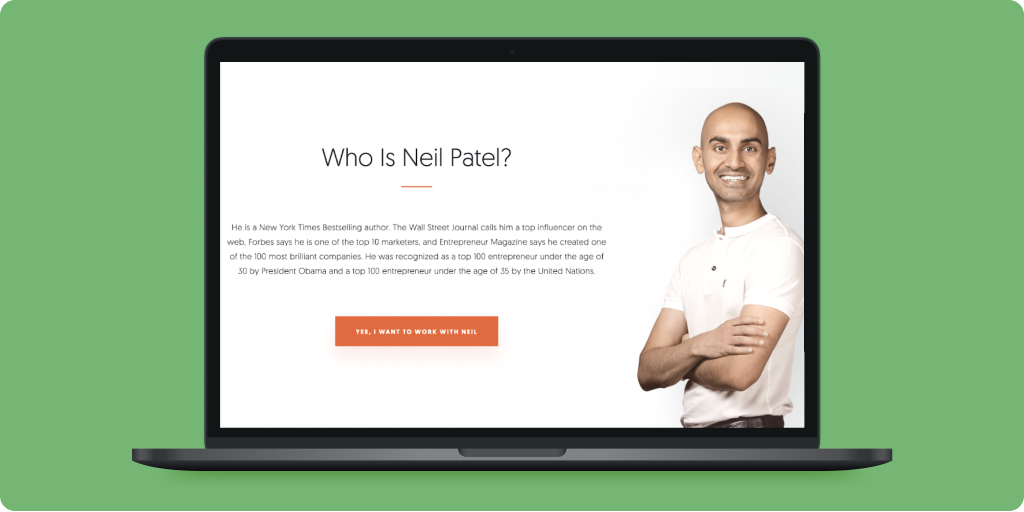 Unforgettable Professional Bios: Examples and How to Write Your Own
Unforgettable Professional Bios: Examples and How to Write Your Own
Discover how to craft a standout professional bio using exceptional examples from industry leaders, and learn expert tips to make your own bio unforgettable.

When it comes to making an impression in the professional world, your bio plays a crucial role. It’s the opportunity for you to showcase your expertise, personality, and achievements, all while connecting with your target audience. But let’s be honest, writing about ourselves can be tough, and finding the right balance between being informative and engaging can be a challenge.
That’s where we come in! In this blog post, we’ll guide you through the process of creating an unforgettable professional bio, using top examples from industry leaders for inspiration. Dive into expert tips, learn about the essential components, and explore different formats to craft a bio that truly stands out. Ready to make your mark? Let’s get started!
You might wonder why successful coaches and educators put so much effort into creating impressive bios. Well, there’s a method to the madness. A standout bio is not just a nice-to-have; it’s an essential tool for these professionals. Let’s explore some reasons why they prioritize crafting engaging bios…
In a nutshell, successful coaches and educators understand the power of a well-crafted bio. They know it’s an essential tool for building trust, connecting with the right people, standing out from the competition, showcasing their personality, and expanding their network. And that’s why they make it a priority to create a bio that truly reflects their unique story and expertise.
Selecting the right narrative style for your professional bio can be a bit of a balancing act. First-person bios have this friendly, chatty vibe that can make you seem more approachable and relatable. But watch out, because too much informality might make you come off as less professional or authoritative. Keep it real, but don’t overdo the “I” statements, or you might sound a tad self-centered.
Now, when it comes to third-person bios, they can give off a more formal and authoritative feel, which can be great in certain situations or industries. The downside? Sometimes they can sound a bit impersonal, like you’re keeping the reader at arm’s length. So, when you’re crafting your third-person bio, try to keep it friendly and polished, making sure you don’t leave your audience out in the cold.
We know that choosing between first-person and third-person bios can be a bit of a challenge. So, we’ve put together two handy tables to give you a quick overview of the pros, cons, use cases, and tips for each format. This way, you can make a more informed decision on which style suits your needs best. Check them out!

“Show, don’t tell” is a writing principle that encourages writers to create a vivid picture through descriptions and actions, rather than simply stating facts or emotions. The idea is to engage the reader’s senses and imagination, making the text more memorable and impactful.
When applied to a first-person bio, this means you should demonstrate your qualities, skills, or experiences through examples or anecdotes, instead of just listing them. By doing so, you create a more engaging and relatable narrative that helps your audience better understand and connect with you.
For instance, instead of saying “I’m a great team player,” you could write, “I’ve successfully collaborated with cross-functional teams to launch innovative marketing campaigns that increased our company’s brand awareness by 30%.” This example demonstrates your teamwork skills while providing context and specific results.

When crafting your professional bio, it’s essential to consider not only the tone and content but also the length. Depending on your purpose and the platform you’re using, the ideal bio length might vary. In this section, we’ll explore the differences between short and long bios, their benefits, and how to choose the right length for your specific needs.
Short bios are ideal for social media platforms like Twitter and Instagram, where character limits are more restrictive. They can also be used as bylines for guest blog posts or when space is limited, such as in conference brochures or speaker profiles.
Advantages of a short bio include their ability to quickly convey essential information and grab the reader’s attention. They are also easier to digest and remember, which can be helpful when you want to make a strong impression in a short amount of time.
When writing a short bio, focus on the most important details, such as your current role, expertise, and key accomplishments. Make every word count, and don’t forget to infuse your personality into the text.
Long bios are better suited for personal websites, LinkedIn profiles, or when you need to provide a more in-depth overview of your career and accomplishments. They allow you to showcase your experience, skills, and personality in greater detail, which can be beneficial when you want to build credibility and connect with your audience on a deeper level.
The advantages of a long bio include the opportunity to provide more context and background information, highlight your achievements and guiding principles, and share personal anecdotes or interests that make you relatable to your audience.
When writing a long bio, start with a strong introduction, followed by a chronological account of your career journey, key accomplishments, and motivations. Don’t forget to inject your personality and authenticity through humor or anecdotes.
To decide on the appropriate bio length, consider the following factors:
In conclusion, the right bio length largely depends on the platform, purpose, and audience. By considering these factors and using the tips and use cases mentioned above, you can create a captivating and effective professional bio that suits your specific needs.
Creating a compelling professional bio is essential for building your personal brand and connecting with your target audience. A well-crafted bio showcases your expertise, accomplishments, and personality, helping you stand out in a competitive landscape. In this step-by-step guide, we’ll walk you through the process of crafting an engaging professional bio that resonates with your audience.
Before you start writing your bio, consider your goals and the audience you want to reach. Are you looking to attract potential clients, employers, or collaborators? Tailor your bio to address their needs and interests while highlighting your unique selling points.
Your professional bio needs a home on the internet where it can be easily accessed by your audience. Depending on your goals and industry, you might choose one or more of the following platforms to showcase your bio:
The length and tone of your bio may vary depending on the platform you choose. For instance, Instagram allows only 150 characters for your bio, while your personal website or Facebook Business page can accommodate a more extensive description.
Once you’ve chosen the appropriate platform(s), create an ‘About Me’ page or section to serve as the home for your professional bio.
Tips for setting up your ‘About Me’ page:
With your ‘About Me’ page in place, you can now focus on crafting the content of your professional bio.
Begin your professional bio by introducing yourself with your full name. If you have a personal brand, include it alongside your name to create a strong and memorable impression. Your personal brand could be a tagline, a unique skill, or a specific area of expertise that sets you apart from others in your field.
After introducing yourself and your personal brand, provide a brief overview of your current role and main responsibilities. This helps your audience understand your expertise and the scope of your work. Be specific about your job title, the company or organization you work for, and the primary tasks you perform.
Tips for describing your current role and responsibilities:
By starting your professional bio with your full name, personal brand, and a clear description of your current role and responsibilities, you create a strong foundation for your audience to engage with your story. As you continue to develop your bio, remember to keep your purpose and audience in mind to ensure your content remains relevant and compelling.
To make your professional bio stand out, showcase your most significant achievements and accomplishments. This could include awards, certifications, successful projects, or milestones in your career. Highlighting your achievements demonstrates your expertise and the value you bring to your industry.
Tips for highlighting achievements and accomplishments:
In addition to your professional accomplishments, your bio should also give your audience insight into your guiding principles and motivations. Sharing your values and passions helps to humanize your bio and makes it easier for your audience to connect with you on a deeper level.
By highlighting your key achievements and showcasing your guiding principles, you create a well-rounded professional bio that captures both your expertise and your personal values. This combination of professional and personal elements helps to engage your audience and create a memorable impression.
Including information about your personal life and interests in your professional bio can help create a more well-rounded and relatable profile. By sharing a few of your hobbies, favorite pastimes, or personal experiences, you can forge a stronger connection with your audience.
Tips for sharing your personal life and interests:
Adding humor or anecdotes to your professional bio can make it more engaging and memorable. A light-hearted tone or a personal story can help humanize your bio and set you apart from others in your field.
Tips for adding humor or anecdotes:
By providing a glimpse into your personal life and interests, and injecting personality and authenticity through humor or anecdotes, your professional bio becomes a well-rounded and engaging representation of who you are. Remember to always tailor your bio to your audience and goals, ensuring it remains a compelling and effective tool for building your personal brand and professional presence.
A short bio is a concise yet powerful tool for introducing yourself and showcasing your expertise. It can be used on social media profiles, conference materials, or other situations where space is limited. To make your short bio captivating and effective, consider the following tips:
Focus on the most important details about your career, achievements, and personal brand. Be selective and prioritize the information that best represents your expertise and goals.
A short bio should be no more than a few sentences or bullet points. Aim for a length between 50 and 150 words, depending on the platform or purpose. Use clear, concise language to convey your message effectively.
Begin with a sentence that grabs your reader’s attention and makes them want to learn more about you. This could be a statement of your expertise, a notable achievement, or a unique aspect of your personal brand.
Writing your short bio in the third person can make it sound more professional and objective. This perspective is particularly suitable for formal situations or platforms where a more authoritative tone is expected.
Emphasize your most impressive skills, accomplishments, or qualities. This helps to quickly establish your credibility and expertise in the eyes of your audience.
Even in a short bio, it’s important to let your unique personality shine through. Include a touch of humor, an interesting hobby, or a memorable anecdote to make your bio more engaging and memorable.
If appropriate, conclude your short bio with a call to action that encourages your audience to connect with you, learn more about your work, or engage with your content. By following these tips, you can create a captivating short bio that effectively communicates your expertise, values, and personality in a limited space.
In this section, we will showcase exceptional professional bio examples from industry leaders across various platforms to provide you with inspiration for crafting your own bio. As you explore these examples, take note of their structure, tone, and the elements they include to make their bios stand out. By applying similar strategies, you can create a professional bio that captures your unique strengths and leaves a lasting impression on your audience!
Brene Brown, a renowned researcher, author, and speaker on vulnerability and courage, has a compelling LinkedIn bio that highlights her expertise, accomplishments, and passion for her work.

Brene Brown’s professional bios across various platforms showcase her expertise, accomplishments, and passion for her work. Let’s dive deeper into her bio to understand how she presents herself effectively.
Gary Vaynerchuk’s professional bios across different platforms are excellent examples of how to promote oneself as an industry leader, entrepreneur, and public speaker. Let’s explore his bio in more detail.

By examining Gary Vaynerchuk’s professional bio, we can learn the importance of showcasing one’s achievements, media presence, and personal brand. Incorporating these elements into your own professional bio can help you effectively promote yourself and leave a lasting impression on your audience.
Marie Forleo’s professional bios across different platforms are prime examples of how to promote oneself as a successful entrepreneur, author, and life coach. Let’s explore her bio in more detail.

By examining Marie Forleo’s professional bio, we can learn the importance of highlighting one’s accomplishments, media presence, and personal brand. Incorporating these elements into your own professional bio can help you effectively promote yourself and leave a lasting impression on your audience.
Tim Ferriss’s professional bios across various platforms serve as excellent examples of how to present oneself as a successful entrepreneur, author, and podcaster. Let’s explore his bio in more detail.

By examining Tim Ferriss’s professional bio, we can learn the importance of highlighting one’s accomplishments, media presence, and unique value proposition. Incorporating these elements into your own professional bio can help you effectively promote yourself and leave a lasting impression on your audience.
Neil Patel is a prominent figure in the digital marketing sphere, and his professional bio serves as a powerful reflection of his expertise and personal brand. Patel’s blog byline is concise, informative, and engaging, making it an excellent example to draw inspiration from.

His bio reads: “Neil Patel is a New York Times bestselling author. The Wall Street Journal calls him a top influencer on the web, Forbes says he is one of the top 10 marketers, and Entrepreneur Magazine says he created one of the 100 most brilliant companies. Neil is a renowned blogger, entrepreneur, and digital marketing expert who has helped numerous businesses grow their online presence.”
In just a few lines, Patel highlights his most notable achievements, including being a New York Times bestselling author and receiving accolades from prestigious publications like Forbes and Entrepreneur Magazine. This instantly establishes his authority in the marketing industry and showcases his personal brand.
His bio also emphasizes his passion for helping businesses grow, which aligns with his professional values and motivations. By mentioning his blogging and entrepreneurial ventures, Patel gives readers a glimpse into his work outside of marketing, making his bio even more engaging.
Neil Patel’s blog byline is an excellent example of a short yet compelling professional bio that effectively communicates his expertise, accomplishments, and personal brand. Use this example as inspiration to craft a captivating bio that resonates with your target audience and showcases your unique offerings.
Crafting a captivating professional bio is an essential step in showcasing your expertise, accomplishments, and unique personal brand. By examining the exceptional bios of industry leaders like Brené Brown, Gary Vaynerchuk, Marie Forleo, and Tim Ferriss, you can glean insights into what makes their bios stand out and connect with their target audiences.
Remember to tailor your bio to your goals and intended audience, and be sure to include essential components such as your full name, occupation, key achievements, guiding principles, and personal interests. Be authentic and inject your personality into your bio, making it relatable and engaging. Keep in mind the format you choose, whether it’s first-person or third-person, and adapt your writing style accordingly.
Leverage the tips and examples provided in this article to create a compelling professional bio that will effectively market you and your brand across various platforms. With a well-crafted bio, you’ll be better equipped to connect with potential employers, clients, or collaborators, and make a lasting impression on the people who matter most in your industry.
Now it’s your turn – take these insights, strategies, and inspiration to craft a professional bio that truly reflects who you are and what you have to offer. Remember, your professional bio is your chance to make a powerful first impression, so make it count!